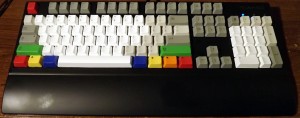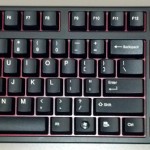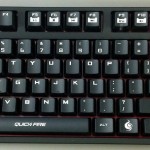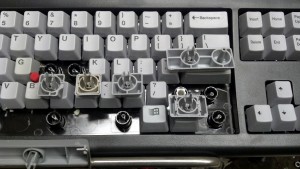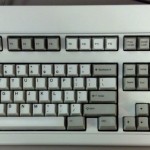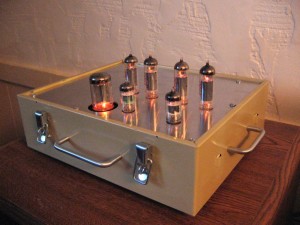Model M Cracked Frame Repair
by Russ Knize on Apr.06, 2012, under Keyboards
This was originally posted on GeekHack in the mods section before we were attacked by r00tworm. I’ll be moving it into the new Wiki at some point.
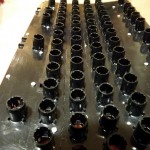 One of the Model M failures that is harder to deal with is cracking of the plastic plate that contains all of the key cap cylinders. Unicomp refers to this as the keyboard “frame”. Severe cracking is usually caused by extended use with broken rivets and/or severe abuse. Between each row are channels where the plastic is thin so that the frame can follow the contour of the backplate. The plastic gets brittle over time and will crack along these channels.
One of the Model M failures that is harder to deal with is cracking of the plastic plate that contains all of the key cap cylinders. Unicomp refers to this as the keyboard “frame”. Severe cracking is usually caused by extended use with broken rivets and/or severe abuse. Between each row are channels where the plastic is thin so that the frame can follow the contour of the backplate. The plastic gets brittle over time and will crack along these channels.
Custom Keyboard from WASD
by Russ Knize on Mar.14, 2012, under Keyboards
Here is a custom keyboard from WASD. This is their V1 with Cherry MX red switches, their snap-on wrist rest, and “50A-R” o-rings. The o-rings reduce the key travel slightly and soften the landing. The slight bounce of the rubber o-ring gives the linear MX red switch a bit of tactility. It is actually a nice compromise between typing and gaming, though they are a bit too soft for me to type fast.
I used their custom keyboard designer, which allowed me to customize the colors and legends of the ABS laser-etched keys. They can also laser-engrave, which I did on the WASD cluster (very helpful, BTW). I went with all symbols on the modifiers. Unfortunately, they were out of dark-gray 1.25 unit modifiers at the time. I did the RGBYO thing, instead. A bit gaudy, but whatever. The Futura font is nice.
Rainbow of Cherries
by Russ Knize on Feb.14, 2012, under Keyboards
My search for a mechanical keyboard that will be quiet enough for home use and yet comfortable to type on led me to geekhack.org. Filled with copious amounts of information about modern production mechanical keyboards, I decided to give some a try. Most of them produced today use switches from Cherry Corporation’s MX line. They use different stem colors to denote the different models. Mechanical keyboards have been coming back, thanks in large part to the gaming community. Four are commonly used switch types are:
- Blue – tactile with a audible click
- Brown – tactile with no click and lighter springs than the blue
- Black – linear with heavier springs than blue
- Red – linear with lighter springs (similar to brown)
There are lot of different brands out there with more coming all the time. In reality, there are only a few manufacturers making them. One of the best regarded, Filco, are made by Costar. Costar has been making boards for other brands using their reference design, which makes use of things like a steel plate that the switches mount to. In other words, you can get a “Filco” for much less than what a Filco-branded board costs.
The MX Brown seemed the most logical one to try first. It was a quiet switch with some tactile feel. I opted for the Rosewill RK-9000, which has a full 104 key set. It’s a very nice, solid board and I am extremely happy with it for typing. However, for gaming I found the tactile feel somewhat distracting. The bump in the stem that provides the feel also contributes a rough feel to the movement of the key.
To address this, I picked up a CM Storm Quick Fire Rapid with MX Red switches. I find this to be much better for gaming. It’s not quite as nice for typing, but it is still better than the previous keyboard I was using at home (Saitek Eclipse II). It is a “tenkeyless” model (no numeric keypad), which is a little weird at first. It’s perfectly fine for gaming, though. It comes with some extra keycaps for the WASD and “super” modifiers. The overall look of the keycaps is somewhat obnoxious. However, it’s still a Costar with a metal mount plate and all that. It is a solid board that just needs some better caps.
The Randomness of Unicomp Keys
by Russ Knize on Feb.13, 2012, under Keyboards
I was looking closely at my Unicomp keyboard, trying to figure out which keys are 2-piece and which are 1-piece. Based on the keyboards I have (1 1994 Model M and 2 Unicomps), the pattern that emerges is:
- Normal keys and 1.5 unit keys (Ctrl/Alt, Tab, and backslash) are 2-piece.
- Larger keys on the Model M (ones with the guide pin, space bar, etc) are 1-piece.
- The 1.25 unit modifiers on the Unicomp keyboards are 1-piece.
- The “notched” G/H/B keys on the Endura Pro are also 1-piece.
The bottom part of the keys are a grab-bag of colors:
IBM Model M Grease Mod
by Russ Knize on Jan.13, 2012, under Keyboards
I did this mod many years ago (probably circa 2003/2004) after reading about the “soft touch” version of the Model M produced by Lexmark. The main motivation was some grumbling from my co-workers (even though the guy right next to me also had a Model M). The grease suppresses the “ping” of the buckling spring without affecting the feel of the keyboard too much. It still feels tactile and still has a click. I did this to my 1994 Model M (which I bought brand-new back then).
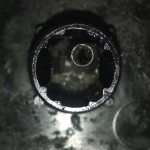 After some experimentation, I found that placing a small amount of dielectric silicone grease into the springs, avoiding the sides of the barrel, works the best. Using a toothpick or paper clip, I dipped the end into the grease tube and twirled it inside of the spring. The goal is just to dampen the ringing of the spring, not to slug the movement of the spring in the barrel. I used a small acid brush to remove any grease at the top of the spring, which can prevent the spring from seating correctly back into the key. If some grease gets into the barrel, it can be removed with a Q-tip and rubbing alcohol.
After some experimentation, I found that placing a small amount of dielectric silicone grease into the springs, avoiding the sides of the barrel, works the best. Using a toothpick or paper clip, I dipped the end into the grease tube and twirled it inside of the spring. The goal is just to dampen the ringing of the spring, not to slug the movement of the spring in the barrel. I used a small acid brush to remove any grease at the top of the spring, which can prevent the spring from seating correctly back into the key. If some grease gets into the barrel, it can be removed with a Q-tip and rubbing alcohol.
Adding more grease gives the keys a softer, slower feel, which I didn’t like. Trying to fill the cavity of the key can render the key intermittent or even inoperable. Definitely avoid greasing any of the stabilizer pins/inserts on the wider keys and the space bar. Some grease on the wire space bar stabilizer is OK and eliminates any rattle that it may have.
SDAC 21
by Russ Knize on Jun.29, 2011, under Daytona
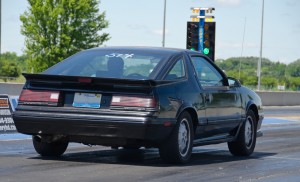 The national convention was back in Chicago again this year. The car show was at the same venue in Fox Lake along with the Chicagoland Mopar Connection’s “Mopars at the Park” show. It was neat seeing such nice FWD Mopars next to the classic iron again. The weather was perfect.
The national convention was back in Chicago again this year. The car show was at the same venue in Fox Lake along with the Chicagoland Mopar Connection’s “Mopars at the Park” show. It was neat seeing such nice FWD Mopars next to the classic iron again. The weather was perfect.
The drags were at Da Grove again as well. I was able to make a few passes. These new tires aren’t as sticky as the old Kumhos were. That along with this hair-trigger ceramic clutch had something to do with my launch problems, I think. The cal has been tuned better since the last time, so my MPH was in the 100s even on the worst pass. But I wasn’t able to beat my previous E/T. Best was 14.343sec @ 102.90mph. Best MPH was 103.66.
Coolant started getting pushed into the overflow at this point, so I called it quits.
| React | 60′ | 1/8 ET | 1/8 MPH | 1/4 ET | 1/4 MPH | Comments |
| 0.845 | 2.565 | 9.861 | 75.27 | 14.897 | 101.69 | First run. Bogged it. |
| 0.320 | 2.553 | 9.626 | 76.36 | 14.637 | 102.50 | Hot-lapped. Spun. |
| 0.827 | 2.710 | 10.065 | 76.43 | 15.056 | 103.17 | Spun then bogged it. |
| 0.663 | 2.685 | 9.938 | 78.11 | 14.876 | 103.66 | Spun like crazy. Hot-lapped. |
| 0.490 | 2.599 | 9.720 | 77.49 | 14.720 | 102.13 | Tried staging rev-limiter at 4k. Spun like crazy. |
| 0.079 | 2.572 | 9.675 | 78.31 | 14.616 | 103.37 | 4k launch, spun. Hot-lapped. |
| 0.941 | 2.337 | 9.352 | 76.76 | 14.343 | 102.90 | 4k launch, feathered the clutch better. Hot-lapped. |
Here is a video of one of the runs taken by Ron M from the SDAC-Chicago club.
Kevlar is Not Bullet Proof
by Russ Knize on Dec.13, 2010, under Daytona
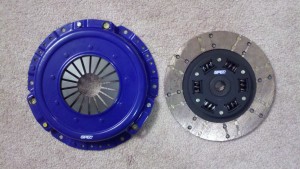 The TU Kevlar clutch that I installed back in ’06 failed. It had been slipping for a few weeks, but it was holding as long as I didn’t go over 5psi of boost or so. Eventually any boost would make it slip, so I broke down and replaced it with this one from SPEC. It is their “Stage 3+” which has a full-faced ceramic-type disc with a supposedly-modified pressure plate. The pedal feel is just like stock, so I am skeptical about that last part. It holds well, but the real test won’t be until the summer tires are back on.
The TU Kevlar clutch that I installed back in ’06 failed. It had been slipping for a few weeks, but it was holding as long as I didn’t go over 5psi of boost or so. Eventually any boost would make it slip, so I broke down and replaced it with this one from SPEC. It is their “Stage 3+” which has a full-faced ceramic-type disc with a supposedly-modified pressure plate. The pedal feel is just like stock, so I am skeptical about that last part. It holds well, but the real test won’t be until the summer tires are back on.
The Kevlar clutch was very chattery, especially while backing up. If I tried backing up a hill, the motor would practically try to fly out of the engine bay. I also experienced a bizarre problem on two occasions where I could not release it. This was in heavy stop-and-go traffic. I suspect the disc warped because it started working again once it cooled-down. I expected better longevity from the Kevlar lining. It should have lasted much longer than the 35k I got out of the ceramic puck clutch in the CSX, but it failed right around the same time. It did have a stock-like feel in terms of engagement. As long as the RPMs were high to avoid the chattering, the engagement was smooth and easy to manage.
The SPEC clutch is “grabby”, just like you would expect from a ceramic type, but not “chattery”. In other words, the pedal has a very narrow band in which you can slip it especially at low RPMs. When you do slip it however, it does not chatter or at least not very much. Backing up is not a problem, other than avoiding a stall. The Kevlar disc had a lot of run out form the sloppy spline and that may have contributed to the problem. The SPEC disc was tighter, but still had some run out.
While the clutch was out, I replaced the 3-4 shift form pads again. I also replaced the fork. I noticed the new pads on the 1-2 fork were also starting to crack, right over the groove carved into the fork while the pads were blown 2 years ago. So I replaced that fork as well with another good set of pads. I also swapped 3rd gear and its syncro with another used one that looked better. It’s nice to have 3rd gear again.
Tubelab Simple PP
by Russ Knize on Apr.28, 2010, under Electron Tube Audio
George from Tubelab was kind enough to send me his latest PCB and some iron for a test build. Easy build and the result was tossed into a disused lock box.
Silver lining to the Comcast DTA
by Russ Knize on Jan.24, 2010, under Linux
While the merits of Comcast’s Digital Transport Adapters are debatable, there is one useful side effect to their existance. Because the are so cheap, they lack a POD tuner. This means that the channel tables are broadcast in-band, which in turn means that a normal QAM tuner can find them. There is a tool called scte65scan that can find these tables using a regular DVB tuner (it also supports the HDHomerun).
Unraveling Comcast digital cable “upgrades”
by Russ Knize on Jan.22, 2010, under Linux
At some point we will become another victim of Comcast’s digital cable “upgrade” plans. We’ve been an analog cable customer of theirs for about 8 years. The only reason we’ve stuck with them is because they are the only provider that can give us good ol’ NTSC on our coax. That is the only way to have all of our cable programming on more than one TV without paying extra each month for each. In addition to the 3 TVs we also use MythTV for our DVR system, which has 3 NTSC and 2 ATSC/QAM tuners.
We are still getting the analog feed, but last week I finally installed the new digital equipment. Their marketing B.S. is confusing and intentionally misleading, but here is what I have learned from the experience:
“Extended Cable” customers are being migrated to the “Digital Starter” package. You get one standard digital cable box, which comes with their “On Demand” feature, and up to two “Digital Transport Adapters”. They give you the impression that the DTAs are you help make up for the loss of analog service on your other TVs, but this isn’t really true (more on this later). After the migration, you will supposedly be left with your primary local stations and a few other useless cable stations like QVC on analog channels 2-17. The rest are only available as digital QAM channels.
This is where it gets ugly. A subset of our old cable lineup is available as unencrypted QAM256 channels, but the others are all encrypted. Some are flagged as encrypted but are actually clear while the rest are fully encrypted. They also sit on random QAM channels/programs that don’t correspond to how they appear in the lineup on the cable box. Comcast is free to move the channels around and play with the encryption whenever they please because they can just reprogram the cable box and DTAs remotely. This makes using your own QAM tuner frustrating, especially since you can’t receive arbitrary basic cable stations due to encryption (like Discovery Channel in my case).
The DTAs are a joke. Comcast makes sure that the channel lineup is only a tiny subset of the lineup you are paying for. They want you to rent real cable boxes, which makes them no better than DirecTV or U-Verse. The DTA will mainly just tune in your “extra” local digital stations in standard definition, but they do NOT tune in your main local stations. For example, if you have a local broadcaster on channel 10, they transmit high-def over the air on channel 10.1 and also probably broadcast a few extra programs on channel 10.2 and 10.3 or more. The DTA will let you view channel 10.2 and 10.3 on your old NTSC TV, but it won’t tune the main channel 10! Comcast provides those as standard def analog stations, but the DTA can’t tune those and the DTA won’t act as a pass-though when it is off like a VCR would (in fact, you can’t turn DTAs off at all). So to watch channel 10, you need an A/B switch on your antenna to switch between the main cable feed and the output of the DTA. The other stations besides the locals that the DTA will receive are fairly useless (more QVC-like stations, Lifetime, and one or two others I’ve never heard of).
So unsurprisingly, Comcast continues to offer less for more. If they provided basic cable stations on unencrypted channels that would be one thing. The only good news in my eyes is that they offer nothing over what you can get from other communication carriers now. All I have to do is put an antenna on the roof.
